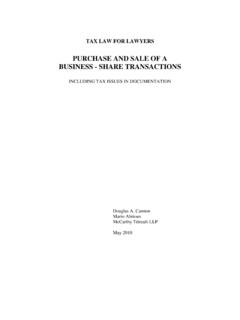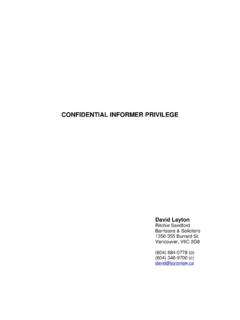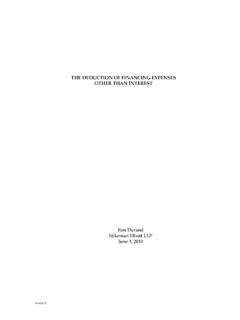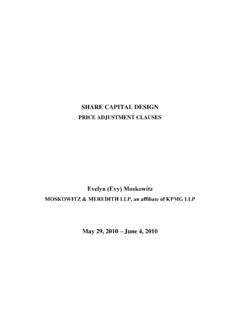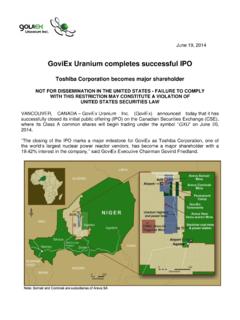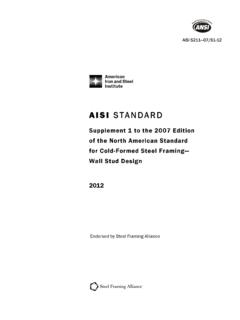Transcription of 2011 TAX LAW FOR LAWYERS - Canadian Bar …
1 TOR_H2 200604240928 0083570 2011 TAX LAW FOR LAWYERS Rollover Provisions of Sections 51, , 86 and BY Donald N. Cherniawsky, , F. Patrick Kirby, , Mike Dolson Felesky Flynn LLP (Edmonton) May 23, 2011 May 29 June 3, 2011 Niagara Falls, Ontario TOR_H2 200604240928 0083570 SECTION 51 CONVERTIBLE PROPERTY EXCHANGE A. Purpose Section 51 provides for a tax-deferred exchange where shares of, or a convertible debt owing by, a corporation are exchanged by the holder for newly-issued shares of and from the same corporation. It covers what are generally referred to as conversions of shares or convertible debt into treasury shares of the same corporation. The shares or convertible debt must be capital property and are referred to as convertible property (although the shares do not need to have conversion rights).
2 In the absence of section 51 (or some other provision that allows a tax-deferred exchange such as section 85 or 86), the exchange would constitute a disposition of the convertible property (see subparagraphs (b)(i) and (ii) of the definition disposition in subsection 248(1)) for proceeds of disposition equal to the value of the shares issued on the exchange, with a resulting capital gain or loss. B. Summary of Key Attributes Advantages Disadvantages No need to convert all shares or debt held by holder. Shares or debt exchanged must be capital property. Generally deemed not to result in a disposition; no reporting or elections required. Only shares1 of issuer can be received no boot.
3 If it is desired to issue boot, then split the transaction into 2, no boot on the section 51 part and use section 85 on the other part. Issuer corporation can be non-resident. Narrow definition of debt. Non-arm s length relationships permissible. Debt must be convertible under its terms (but CRA may allow adding conversion feature). 1 Capital property debt-for-debt rollover available under section - 2 TOR_H2 200604240928 0083570 Cannot recognize loss (consider electing under subsection 85(1)) C. Detailed Analysis 1. Basic Rules Subsection 51(1) The shares or debt of the corporation must be exchanged for treasury shares of the same corporation.
4 The exchange must occur with the issuer; section 51 does not apply to an exchange of issued shares of a corporation between two of its shareholders. It also does not apply to an exchange of shares of one corporation for shares of another corporation. There is no difference in treatment in section 51 between common shares and preferred shares. There is also no requirement that the corporation be a Canadian corporation. Therefore, the rules can apply to exchanges of shares or debt of non-resident corporations. The shares or debt being surrendered in exchange for shares must be held by the taxpayer as capital property. If not held as capital property, then the subsection does not apply and income or losses would be recognized on the exchange (subject to an election under section 85).
5 Paragraph 51(1)(a) describes the case in which a share is exchanged for another share of the same corporation. The share that is surrendered must be capital property of the taxpayer, but it is not necessary that it have the conversion feature built into its terms. The section can cause confusion because it uses the term convertible property as a defined term. Therefore, any exchange of a share that is capital property for another share of the corporation that is not covered under another section of the Act can potentially qualify under section 51 without regard to whether its terms and conditions provide for the exchange. Paragraph 51(1)(b) describes the case in which a debt (referred to as a bond, - 3 TOR_H2 200604240928 0083570 debenture or note ) is exchanged for a share of the corporation.
6 The debt must be capital property but, in addition, its terms must confer on the taxpayer the right to make the exchange. That is to say, the conversion feature must be included in the terms of the debt instrument for section 51 to apply. Paragraph 5 of CRA Interpretation Bulletin IT-448: Dispositions Changes in terms of securities indicates that an optional conversion feature can usually be added to a security without triggering a disposition of the The convertible indebtedness referred to is more restricted than in other provisions of the ITA in that there is no reference to a mortgage, bill, or similar obligation . See for example the definition of qualifying debt obligation in subsection (3).
7 Paragraph 9 of CRA Interpretation Bulletin IT-96R6 clarifies that where a conversion feature is not separable from the security and cannot be traded separately, the rules in section 49 dealing with options do not apply. No non-share consideration ( boot ) can be received by the taxpayer on the exchange. Nevertheless, the administrative position of the CRA is that where the taxpayer would otherwise receive a fraction of a share on the exchange, and the taxpayer instead receives cash or other non-share consideration in lieu of the fraction, the taxpayer may obtain a tax-deferred exchange despite the receipt of the boot but is required to reduce the adjusted cost base of the whole shares received on the exchange by the amount of such boot.
8 Alternatively, the taxpayer may choose to report the gain or loss on the amount received in lieu of the fraction. This administrative policy of allowing the taxpayer the ability to ignore the gain or loss does not apply if the value of the boot 2 See also Income Tax Ruling TR-66; CRA Interpretation Bulletin IT-146R4: Shares entitling shareholders to choose taxable or capital dividends, paragraph 2; 1996 CTF Corporate Management Tax Conference Report, Revenue Canada Forum, Question 20; and CRA Income Tax Technical News No. 14, December 9, 1998. - 4 TOR_H2 200604240928 0083570 received in lieu of the fraction exceeds $ This makes the potential to issue boot very limited.
9 If all of these requirements are met, then the result of the application of section 51 is as follows: (a) The taxpayer is deemed by paragraph 51(1)(c) not to have disposed of the shares or debt surrendered on the exchange (except for the purposes of subsection 20(21) relating to overaccrual of interest income and proposed subsections (6) and paragraph 94(2)(m) relating to non-resident trusts). Therefore, no gain or loss is recognized by the taxpayer. (b) The cost to the taxpayer of the shares issued to the taxpayer on the exchange is deemed to be equal to the taxpayer s adjusted cost base of the shares or debt surrendered on the exchange. (c) Where the taxpayer is issued shares of more than one class on the exchange, the taxpayer s adjusted cost base of the shares or debt surrendered on the exchange is allocated to the shares of the various classes issued to the taxpayer based on their relative fair market values.
10 ACB is allocated based on the formula in paragraph 51(1)(d) A x B C A = ACB of the surrendered property B = FMV, immediately after the exchange, of all shares of the particular class acquired on the exchange by the taxpayer. C = FMV, immediately after the exchange, of all shares acquired on the exchange by the taxpayer. 3 See CRA Interpretation Bulletin IT-115R2: Fractional Interest in Shares. - 5 TOR_H2 200604240928 0083570 (d) Once the adjusted cost base of the shares issued on the exchange has been determined, there is a subsequent adjustment in paragraphs 51(1)( ) and ( ) that applies if any of the shares or debt surrendered on the exchange have their adjusted cost base reduced as a result of the rules in section 80 dealing with debt forgiveness.

